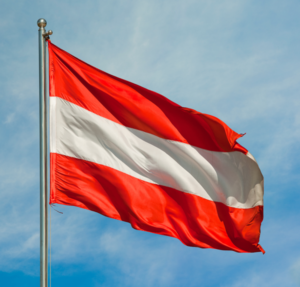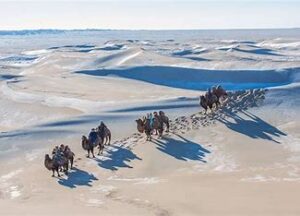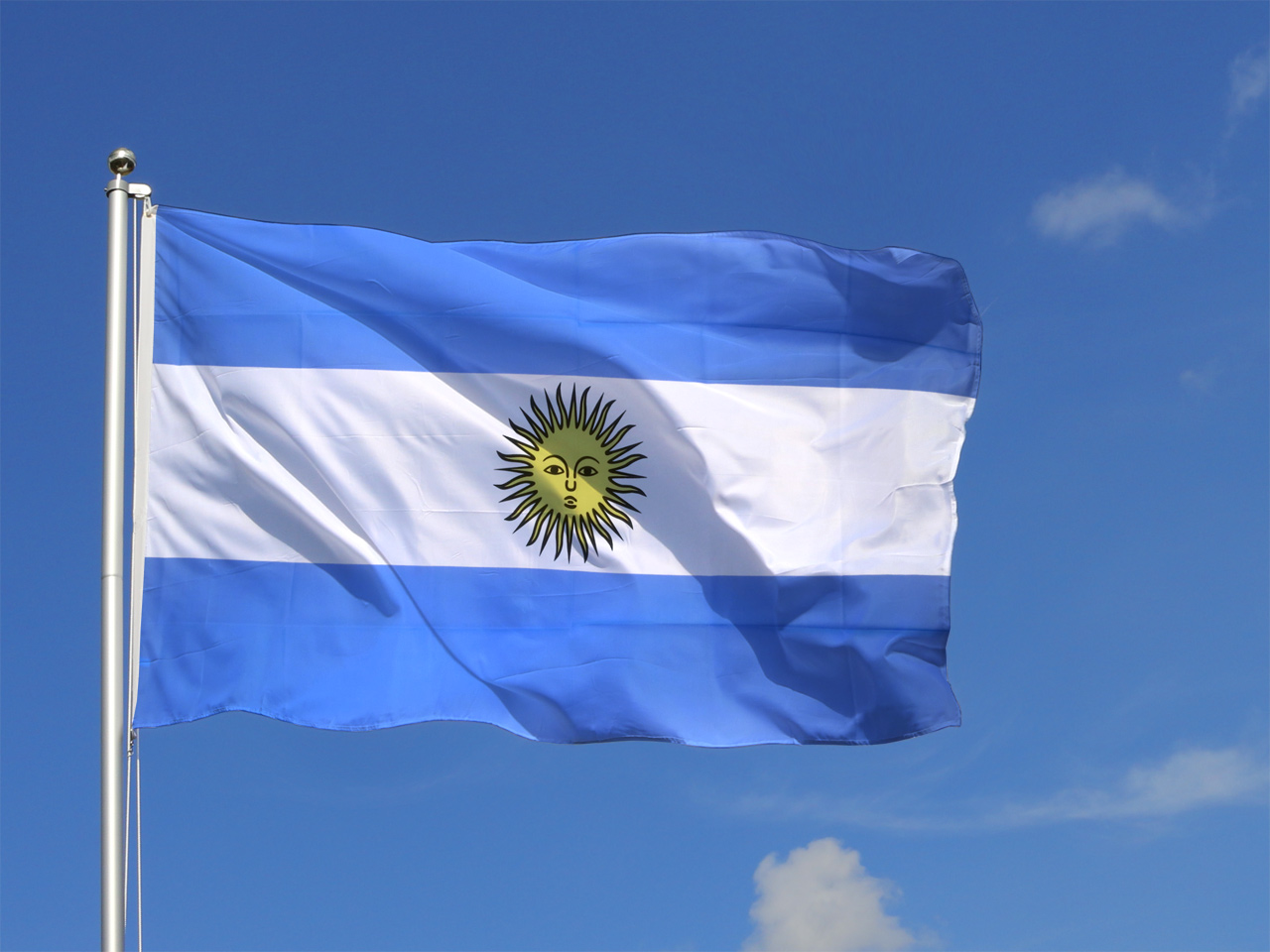
Argentina, a land of diverse landscapes and vibrant culture, is also a treasure trove of historical sites that offer tourists a glimpse of its rich past.
From ancient indigenous civilizations and colonial architecture to sites of political significance, the country boasts a wealth of destinations that captivate history enthusiasts and casual tourists alike.
This guide explores the top 10 historical sites in Argentina, each narrating a unique story that contributes to the nation’s cultural tapestry.
Whether you’re an avid historian or simply curious about Argentina’s heritage, these sites promise an enriching and memorable experience.
1. Iguazu Falls:
2. Perito Moreno Glacier:
3. La Recoleta Cemetery:
4. Casa Rosada:
5. Tierra del Fuego National Park:
6. Salta:
7. Quebrada de Humahuaca:
8. Córdoba Jesuit Block:
9. Bariloche:
10. Mendoza Wine Region:
1. Iguazu Falls Argentina:
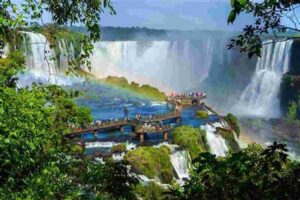
Iguazu Falls, located on the border between Argentina and Brazil, is one of the most spectacular natural wonders of the world.
The falls span 2.7 kilometers across the Iguazu River, featuring about 275 individual cascades and waterfalls, each varying in height and intensity.
The most famous of these is the Devil’s Throat (Garganta del Diablo), a U-shaped chasm that drops over 80 meters (262 feet) and creates a mesmerizing and thunderous spectacle.
Iguazu Falls, within Iguazu National Park, a UNESCO site, showcases lush rainforest, diverse flora, abundant wildlife, and vibrant ecosystem.
Visitors can explore the park via a network of well-maintained walkways and trails that offer numerous vantage points to view the falls up close.
One of the highlights is the Superior Circuit, which provides panoramic views from above, while the Inferior Circuit allows for a more intimate experience at the base of the falls.
The park also features a thrilling boat ride that takes visitors right into the heart of the mist and spray of the falls, providing an exhilarating perspective.
For those interested in the region’s cultural history, the nearby ruins of the Jesuit Missions and the indigenous Guarani communities add an enriching historical dimension to the visit.
The park’s visitor center provides information on the ecological and geological significance of the falls and the surrounding area.
Iguazu Falls is an unforgettable destination, combining natural beauty, adventure, and history; consequently, it is a must-visit in Argentina.
Iguazu Falls is one of the historical sites, offering an unforgettable experience, combining natural beauty, adventure, and a touch of history, making it a must-see for tourists traveling to Argentina.
Whether you’re a nature lover, adventure seeker, or history enthusiast, Iguazu Falls promises a mesmerizing and enriching journey.
2. Perito Moreno Glacier Argentina:
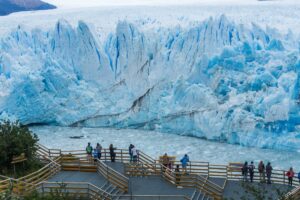
Perito Moreno Glacier, located in Los Glaciares National Park in the Argentine Patagonia, is one of the most spectacular and accessible glaciers in the world.
Spanning 250 square kilometers (97 square miles) and stretching over 30 kilometers (19 miles) in length, this colossal glacier is renowned for its stunning beauty and dynamic ice movements.
Unlike most glaciers that are retreating, Perito Moreno is unique as it remains in equilibrium, periodically advancing and retreating in a captivating natural cycle.
Visitors witness massive ice calving into Lake Argentino, creating a mesmerizing display of nature’s power with thunderous splashes.
The glacier’s face rises approximately 74 meters (240 feet) above the lake surface, providing a dramatic and picturesque backdrop.
A well-developed network of walkways and viewing platforms offers tourists multiple vantage points to observe the glacier from various angles.
A well-developed network of walkways and viewing platforms, therefore, offers tourists multiple vantage points to observe the glacier from various angles.
One of the most popular activities is the boat tour, which not only takes visitors close to the glacier’s towering ice walls but also offers a unique perspective and photo opportunities.
El Calafate, the gateway to the glacier, offers accommodations, dining, visitor centers, and essential traveler amenities.
The natural beauty and accessibility of Perito Moreno Glacier make it a must-visit destination for nature lovers, photographers, and adventure seekers alike.
Perito Moreno Glacier promises an unforgettable experience with its scale, ice calving, and stunning Patagonian landscape.
3. La Recoleta Cemetery Argentina:
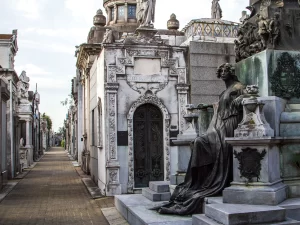
La Recoleta Cemetery, located in the upscale Recoleta neighborhood of Buenos Aires, Argentina, is one of the world’s most famous historical sites and cemeteries and a must-visit for tourists.
Established in 1822, this labyrinthine cemetery spans over 14 acres, serving as the final resting place for Argentina’s notable figures.
Among its most visited graves is that of Eva Perón, the beloved First Lady of Argentina.
The cemetery is renowned for its stunning and diverse architecture, featuring an array of elaborate mausoleums, statues, and tombs that reflect a mix of Art Deco, Art Nouveau, Baroque, and Neo-Gothic styles.
Each mausoleum tells its own story through intricate details and symbolic sculptures, creating an open-air museum of Argentine history and art.
Marble angels, weeping willows, and dramatic crypts adorn the narrow pathways; thus, inviting visitors to explore and reflect.
La Recoleta is more than just a cemetery; it’s a cultural and historical landmark.
Guided tours are available, providing insights into the lives of the famous individuals buried there and the fascinating stories behind the ornate tombs.
The cemetery’s layout, with its tree-lined avenues and peaceful atmosphere, consequently offers a serene escape from the bustling city.
Adjacent to the cemetery is the Recoleta Cultural Center, which hosts art exhibitions, concerts, and cultural events, enhancing the area’s vibrant atmosphere.
Numerous cafes and shops in the surrounding area make it a perfect spot to relax and soak in the ambiance after your visit.
Several cafes and shops in the surrounding area, consequently, make it a perfect spot to relax and soak in the ambiance after your visit.
A visit to La Recoleta Cemetery is a journey through Argentina’s past, offering a poignant and beautiful experience that blends history, art, and architecture in a truly unique setting.
4. Casa Rosada Argentina:
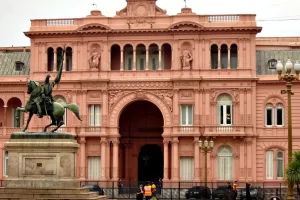
Tourists can explore Casa Rosada, or the Pink House, is one of the historical sites, that stands as a historic emblem at the heart of Buenos Aires, Argentina, blending architectural grandeur with political significance.
This iconic building serves not only as the official seat of the Argentine executive branch but also as a symbol of the nation’s tumultuous history and enduring democratic spirit.
Located on the eastern edge of Plaza de Mayo, Casa Rosada’s distinctive pink hue is a result of its exterior made from a mix of lime and ox blood, a nod to its origins dating back to the 19th century.
Visitors are drawn not only by its striking color but also by the rich stories that unfold within its walls.
The building itself is a blend of architectural styles, showcasing elements from Italian Renaissance and French neoclassical influences.
Tourists flock to Casa Rosada not only for its architectural allure but also for its historical significance.
Of course, it was from the famous balcony facing the Plaza de Mayo that Argentina’s esteemed First Lady, Eva Peron, delivered rousing speeches to the crowd.
With this in mind, the balcony has become a symbol of democracy and activism, witnessing countless political demonstrations and national celebrations over the years.
Guided tours today allow visitors to explore ornate halls and rooms where Argentine presidents conducted state affairs, offering historical insight.
Exhibitions within the building delve into Argentina’s political history, offering insight into pivotal moments that shaped the nation.
Whether for its architectural beauty, its political resonance, or its cultural significance, Casa Rosada stands as a testament to Argentina’s vibrant past and its enduring spirit.
A visit here is not just a journey through history but a glimpse into the heart of Argentine identity.
5. Tierra del Fuego National Park Argentina:
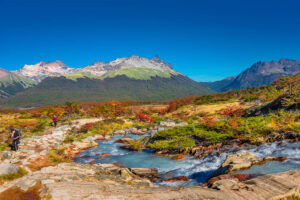
Tierra del Fuego National Park, nestled at the southernmost tip of Argentina, is a pristine wilderness that encapsulates the rugged beauty of Patagonia.
Covering 63,000 hectares of diverse landscapes—dense forests, snow-capped mountains, and pristine lakeshores—the park offers an unforgettable experience.
Located near the city of Ushuaia, often referred to as the “End of the World,” Tierra del Fuego National Park serves as a gateway to the dramatic landscapes of the southern Andes and the Beagle Channel.
The park’s trails wind through ancient southern beech forests (Nothofagus), where mosses and lichens create a mystical atmosphere; moreover, the trails offer a unique opportunity to immerse oneself in nature.
Similarly, visitors can hike along well-marked paths like the Coastal Path and the Pampa Alta Trail, which offer stunning views of Lapataia Bay and the surrounding mountain ranges.
The park hosts abundant wildlife: Magellanic woodpeckers in trees, Andean condors overhead, and lucky visitors may glimpse gray foxes and guanacos roaming.
Magellanic woodpeckers and Andean condors are seen among trees; lucky visitors spot South American gray foxes and guanacos roaming.
Birdwatchers can delight in spotting endemic species like the austral parakeet and black-browed albatross along coastal cliffs, ideal nesting sites for seabirds, enhancing the birdwatching allure.
Additionally, for those seeking a more immersive experience, camping facilities are available within the park, allowing visitors to wake up to the serene sounds of nature.
Southern summer (December to March) offers ideal weather for exploring, with longer daylight hours enhancing the enjoyment of the park’s beauty.
Tierra del Fuego National Park showcases Patagonia’s raw, untouched landscapes, inviting travelers to explore its awe-inspiring vistas and rich biodiversity.
Whether hiking, birdwatching, or soaking in nature’s tranquility, a visit here promises an unforgettable adventure at the “End of the World.”
6. Salta Argentina:
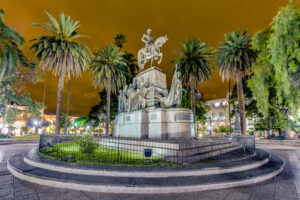
Nestled in the northwest corner of Argentina, Salta beckons travelers with its rich blend of colonial architecture, stunning landscapes, and vibrant cultural heritage.
Known as “La Linda” (The Beautiful), Salta enchants visitors with its well-preserved Spanish colonial buildings, cobbled streets, and a laid-back atmosphere that embodies the essence of Argentine charm.
The city’s central Plaza 9 de Julio serves as a bustling hub surrounded by elegant arcades, where locals and tourists mingle amid cafes and shops.
Nearby, the San Francisco Church and Convent boasts a striking baroque facade. Furthermore, it houses an impressive collection of colonial art, making it a must-see for art enthusiasts and history buffs alike.
Salta’s cultural richness extends beyond its architecture.
Additionally, the city is renowned for its folk music and dance, with peñas (traditional music venues) offering lively performances of zamba and chacarera.
Visitors can savor regional cuisine influenced by Andean and Spanish traditions, such as empanadas salteñas and locro, a hearty stew.
Surrounded by the Andes Mountains, Salta is a gateway to spectacular natural beauty.
In fact, the nearby Quebrada de Cafayate showcases stunning rock formations, including the iconic Amphitheater, sculpted by wind and water over millennia.
The Tren a las Nubes (Train to the Clouds) departs from Salta, offering a breathtaking journey through dramatic mountain scenery and crossing towering viaducts.
Whether exploring its historical sites like streets, savoring its culinary delights, or marveling at its natural wonders, Salta captivates tourists with its blend of culture, history, and stunning landscapes, making it a must-visit destination in Argentina.
7. Quebrada de Humahuaca Argentina:
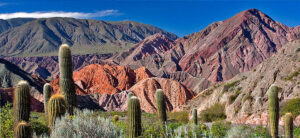
Tourists can visit Quebrada de Humahuaca as one of the UNESCO World Heritage and historical sites located in the northern province of Jujuy, Argentina.
It is a breathtaking gorge that winds through the Andean foothills, offering a journey through both natural beauty and indigenous culture.
Stretching over 150 kilometers from the city of Jujuy to the border with Bolivia, this ancient valley has been a vital trade route and cultural corridor for millennia, inhabited by various indigenous communities whose traditions and customs continue to enrich the region.
The landscape of Quebrada de Humahuaca is characterized by towering multicolored cliffs. Moreover, these cliffs shift in hue with the changing light, creating a stunning backdrop against the clear blue skies.
In general, the palette of reds, purples, greens, and yellows in the rock formations contrasts sharply with the arid plains, creating a surreal and captivating vista.
Dotting the valley are small, picturesque villages where adobe houses with thatched roofs blend harmoniously into the rugged terrain.
Other notable stops include Purmamarca, famed for its Cerro de los Siete Colores (Hill of Seven Colors), as well as Tilcara, home to the Pucará de Tilcara, an ancient pre-Incan fortress.
Visitors to Quebrada de Humahuaca can explore its rich heritage through museums, craft markets, and encounters with local Quechua-speaking communities, who maintain their traditional way of life.
The region’s festivals, music, and cuisine, influenced by indigenous Andean traditions, provide a deeper insight into its vibrant cultural tapestry.
Certainly, Quebrada de Humahuaca offers a mesmerizing journey through natural and human history, making it a highlight of northern Argentina trips.
8. Córdoba Jesuit Block Argentina:
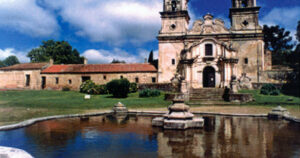
Tourists can explore the Córdoba Jesuit Block, a UNESCO World Heritage Site and one of the historical sites in the heart of the city of Córdoba, Argentina, is a testament to the ingenuity and cultural exchange of Jesuit missionaries during the 17th and 18th centuries.
This historic complex comprises several architectural gems that reflect the religious, educational, and artistic endeavors of the Society of Jesus in colonial Latin America, thus showcasing their multifaceted contributions to the region.
At the center of the Jesuit Block stands the imposing Córdoba Cathedral, whose grandeur and Baroque architecture are a stark contrast to the simplicity of its Jesuit origins.
Nearby, the Jesuit university, known as the Universidad Nacional de Córdoba today, was once a pioneering center of learning in the New World, with its original buildings showcasing a blend of European and indigenous architectural styles.
Visitors can explore the Manzana Jesuítica (Jesuit Block), which includes the Church of the Society of Jesus (Iglesia de la Compañía de Jesús) and its captivating interior adorned with intricate carvings and frescoes.
The former Jesuit residence, now the National College of Monserrat, not only provides a glimpse into the daily lives of the missionaries but also their students.
The Jesuit Block is not just a collection of buildings; it represents a cultural exchange that shaped the region’s history, art, and education.
Furthermore, the adjacent Jesuit Estancias (rural estates), also UNESCO-listed, further illustrate the Jesuits’ holistic approach to community development and their profound impact on Argentine society.
9. Bariloche Argentina:
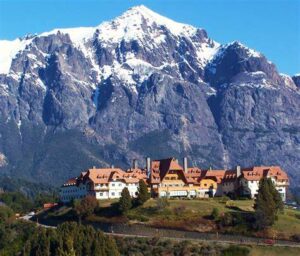
Nestled in the Argentine Patagonia amid the stunning Andes Mountains and along the shores of Lake Nahuel Huapi, San Carlos de Bariloche, commonly known as Bariloche, captivates visitors with its breathtaking natural beauty and alpine charm.
Additionally, this picturesque town is a haven for outdoor enthusiasts, offering a perfect blend of adventure, relaxation, and scenic splendor.
Bariloche is renowned for its Swiss-inspired architecture, with chalet-style buildings nestled against a backdrop of snow-capped peaks and lush forests.
The city center, bustling with chocolate shops, breweries, and artisanal stores, exudes a cozy and inviting atmosphere that, moreover, reflects its European influence.
The surrounding landscape beckons exploration, with hiking trails leading to panoramic viewpoints such as Cerro Campanario and Cerro Otto, where visitors can marvel at sweeping vistas of lakes, forests, and mountains.
In winter, Bariloche transforms into a snow sports paradise, attracting skiers and snowboarders to its world-class resorts like Cerro Catedral.
Lake Nahuel Huapi offers opportunities for boating, kayaking, and fishing, while its beaches provide serene spots for picnicking and relaxation.
The nearby Circuito Chico, a scenic drive or bike route, winds through forests and past crystal-clear lakes, offering glimpses of local wildlife and photogenic vistas.
Bariloche is also famous for its chocolate industry, with numerous chocolatiers offering decadent treats crafted from locally sourced ingredients.
Visitors can indulge in chocolate tastings and learn about the region’s sweet traditions.
Whether exploring its natural wonders, savoring its culinary delights, or simply soaking in its alpine atmosphere, Bariloche promises an unforgettable experience for travelers seeking adventure and tranquility in the heart of Patagonia.
10. Mendoza Wine Region Argentina:
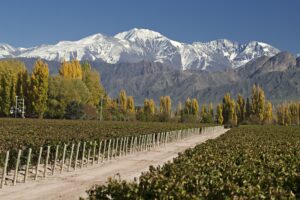
The Mendoza Wine Region, nestled at the foothills of the majestic Andes Mountains in western Argentina, is a paradise for wine lovers and adventurers alike.
Known as one of the world’s most famous historical sites and premier wine capitals, Mendoza Argentina has a rich viticultural heritage dating back to the 16th century, a picturesque destination for tourists dating back to when Spanish colonists first settled in this fertile land. Grape vines were planted.
The region’s exceptional terroir, characterized by sunny days, cool nights, and nutrient-rich soils irrigated by the pure waters of the Andes, provides the perfect conditions for grape cultivation.
Malbec, the flagship varietal of Argentine wine, thrives here, producing bold and flavorful wines that have gained international acclaim.
With this in mind, visitors to the Mendoza Wine Region can explore its diverse vineyards, from sprawling estates to boutique wineries tucked away in the countryside.
Guided tours offer insights into the winemaking process, from vine to bottle; additionally, tastings allow travelers to sample a variety of wines, including Malbec, Cabernet Sauvignon, Torrontés, and more.
The landscape of Mendoza is as breathtaking as its wines, with vineyards set against a backdrop of snow-capped peaks and rolling hills.
The Uco Valley, in particular, has gained popularity for its high-altitude vineyards and premium wines.
Beyond wine, Mendoza offers a wealth of outdoor activities. Adventurers can hike in the Andes, ski in the winter months, or enjoy horseback riding through vineyards.
The city of Mendoza itself is vibrant, with tree-lined streets, bustling plazas, and excellent restaurants serving regional cuisine paired with local wines.
Whether for wine tasting, outdoor adventure, or simply soaking in the stunning scenery, the Mendoza Wine Region promises an unforgettable experience that celebrates Argentina’s passion for wine and its natural splendor.



